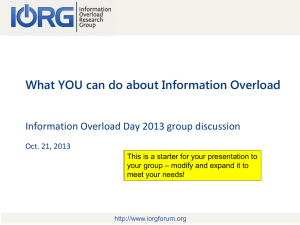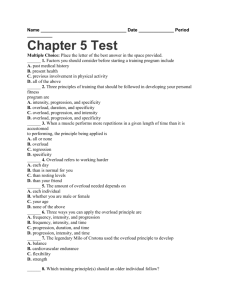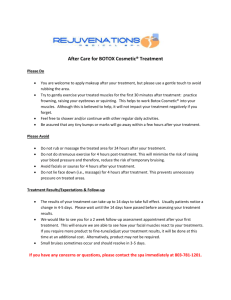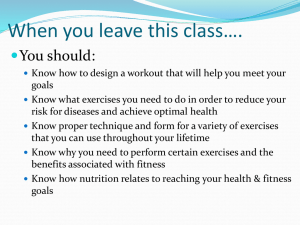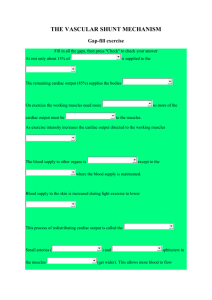Fitness Training, Acute Responses, Training
advertisement
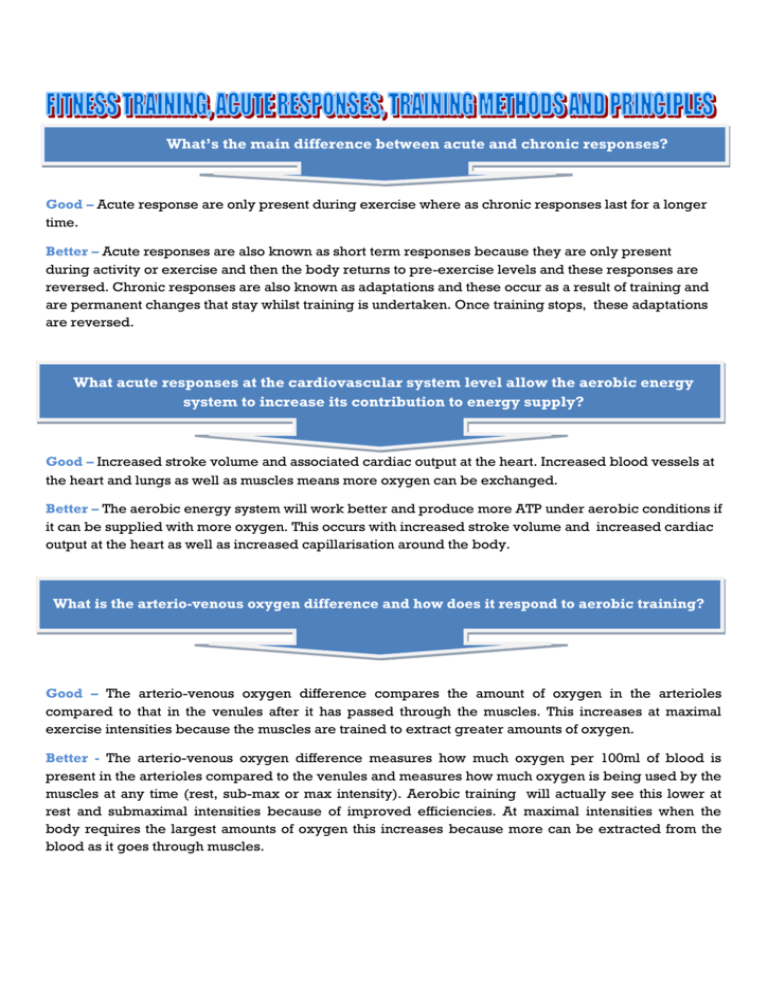
What’s the main difference between acute and chronic responses? Good – Acute response are only present during exercise where as chronic responses last for a longer time. Better – Acute responses are also known as short term responses because they are only present during activity or exercise and then the body returns to pre-exercise levels and these responses are reversed. Chronic responses are also known as adaptations and these occur as a result of training and are permanent changes that stay whilst training is undertaken. Once training stops, these adaptations are reversed. What acute responses at the cardiovascular system level allow the aerobic energy system to increase its contribution to energy supply? Good – Increased stroke volume and associated cardiac output at the heart. Increased blood vessels at the heart and lungs as well as muscles means more oxygen can be exchanged. Better – The aerobic energy system will work better and produce more ATP under aerobic conditions if it can be supplied with more oxygen. This occurs with increased stroke volume and increased cardiac output at the heart as well as increased capillarisation around the body. What is the arterio-venous oxygen difference and how does it respond to aerobic training? Good – The arterio-venous oxygen difference compares the amount of oxygen in the arterioles compared to that in the venules after it has passed through the muscles. This increases at maximal exercise intensities because the muscles are trained to extract greater amounts of oxygen. Better - The arterio-venous oxygen difference measures how much oxygen per 100ml of blood is present in the arterioles compared to the venules and measures how much oxygen is being used by the muscles at any time (rest, sub-max or max intensity). Aerobic training will actually see this lower at rest and submaximal intensities because of improved efficiencies. At maximal intensities when the body requires the largest amounts of oxygen this increases because more can be extracted from the blood as it goes through muscles. How is overload applied to training? Good - Overload can be applied by: • increasing the number of repetitions • increasing the number of sets • increasing the distance • increasing the intensity within the set zone • increasing the duration of work • decreasing the amount of rest. Better – I like the examples provided earlier but these need to be qualified to ensure specificity is still being maintained. For example, increasing the distance of a sprint in an interval program might not replicate what in happening in a game or competition. Increasing the intensity might not be an option if performers are already performing maximally. Decreasing the amount of rest might not allow for sufficient PC restoration and then be working a different energy system to that primarily being sought to develop. Comments: Whenever looking to apply overload the training goals and existing performance levels and to be closely considered. In addition to the above examples, if muscular power is looking to be developed, increasing the reps might actually start to develop local muscular endurance. List as many training methods as you possibly can and briefly discuss important aspects of each. Good - Specificity, intensity, duration, overload and frequency are the main ones and then there’s variety and individuality which is a bit like specificity. Specificity is about doing things in training that mimic what happens in the game; intensity is about how hard training is conducted at; duration is how long each training session lasts for. Overload means making the training harder once adaptations have occurred and frequency. Variety is all about making the training different to keep motivation levels high and individuality means making the training specific to the individual demands of the game. Better – SIDOF stands for specificity, intensity, duration, overload and frequency. There’s also DRIVM(drivem) which stands for diminishing returns, reversibility, individuality, variety and maintenance. Specificity ensures that training replicates what happens during the actual competition in terms of the muscles used in the same way they are used to execute skills; the work to rest ratios are kept similar and the associated energy systems are used in the same way. Intensity looks are reproducing game intensities during training and ensuring that minimum thresholds are achieved to ensure correct training of the energy systems. Duration can mean either the length of each session or the length of microcycles in the training program. Frequency is how many times per week the training is done and overload sees the training being made progressively harder as training gains are achieved. As more gains are made, even with overload, gains become harder to achieve and this is known as the law of diminishing returns. A fitter athlete will find it harder to make gains than someone who is just staring out because of diminishing returns too. Training gains are reversible and will return to pre-training levels if training is reduced or stops. Individuality takes into consideration the current levels of fitness athletes are at and then takes into consideration their own strengths and weaknesses and a training program is designed accordingly. Variety sees different training types being put into a program occasionally to keep programs interesting and maintenance occurs when a desired fitness level is reached and training is undertaken 2 times per week to ensure that these levels are not lost – this tends to occur a lot during the “offseason” part of a training program. Comments – The better answer uses easy to remember acronyms to come up with the main and associated training principles that are important for any training program. The explanation of individuality being like specificity is incorrect as they are different principles. The second answer actually shows a greater depth of understanding and application in the examples provided. Anaerobic training essentially targets fast twitch fibres. Discuss three fast twitch fibre changes that might result from resistance training and how these contribute to improved performance. Good – Increased fibre size which would result in more forceful contractions. More PC can be stored so use of the ATP-PC system can be prolonged. There would also be more glycolytic enzymes so he LA system can produce anaerobic ATP at a faster rate. Better – Increase fibre size allows for greater storage of energy fuels such as PC and glycogen which can be used by the ATP-PC and Anaerobic glycolysis systems for longer – these both provide ATP at the fastest rate Resistance training (power or speed) both lead to increases in the rate of force development and time for which maximum force can be maintained which both mean greater application of power and strength is possible. Resistance training improves the structure and function of the tendons and ligaments which in turn allows for greater attachment of muscle to bone greatly assisting in force production. Discuss at least two respiratory changes that result from aerobic training and again, how these contribute to improved performance Good – Increased lung capacity and increased gas exchange at the alveoli which all bring more oxygen into the body and ultimately the muscles too Better – Increased tidal volume and increased lung capacity and also greater alveolar surface area. Collectively these allow more oxygen to be taken into the lungs and then distributed to working muscles – it also allows for greater exchange rates of carbon dioxide which delays fatigue. In the same way that the heart becomes more efficient so too do the respiratory muscles which include the intercostals and the diaphragm. Because these need les oxygen up to submaximal levels there is more oxygen available to working muscles


